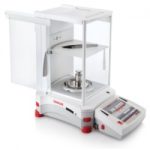In this article, you’re going to learn the correct way to use an analytical balance. These weighing devices are much more sensitive, accurate, and precise than larger topload balances or industrial scales. Analytical balances are used for low mass samples, where specific weights are needed.
Before using the balance, you need to make sure that it’s level. Start by checking the level bubble. If the bubble is located within the black circle then the balance is level; if the bubble is outside of this circle then the balance is not level. If you find a balance that is not level, carefully adjust the foot on each corner until the bubble is located in the center. In most cases, you should not attempt to move an analytical balance because they are very sensitive. However, if you do then you will want to make sure the balance is still weighing correctly.

Before you start, you should make sure that the inside of the balance is clean and dry. You should also make sure that all of the doors are closed when you are recording your masses, which prevents air from flowing through the balance. These balances are so sensitive that even air pressure can affect their readings. Now you can begin. The balance should already be turned on with a reading of 0.00 grams on the display. If the display says something other than zero, push the “zero” button. This will reset the balance to 0.00.
The display will also indicate the units of mass. The analytical balance can report masses in several units, so you should ensure to set yours to grams in most cases. Make sure your item is clean and dry, and then gently open one of the doors. Place your item inside and gently close the door. Wait for the reading to stabilize, then record. To remove the item, open the door, just as before, remove your item, and close the door gently.
Precautions When Using Analytical Balances
Because analytical balances are much more sensitive than top load balances, there are a few extra preventative measures to keep in mind. You should never put liquid inside the analytical balance unless specifically instructed to do so. If you do have to put liquid in there, make sure you use a container that seals tightly.
If there are ever any spills inside the analytical balance, clean it up according to the manufacturer instructions. It’s not usually a good idea to add a substance to your object while on the analytical balance. A better choice would be to remove your item, add your sample, and place it back into the balance.
If you need to take multiple measurements of the same item, make sure to use the same balance each time. There is a small error associated with each of the balances, using the same one keeps it consistent so that it cancels out the difference.
For the most accurate results, you shouldn’t handle the sample with your bare hands. You should use gloves or tongs to handle your sample because the oils on your finger can transfer to the glass, which will be picked up by the analytical balance.
You should never lean on the bench when using the analytical balance because this small difference can alter the weight slightly. Make sure the item that you are placing into the analytical balance is at room temperature. If it’s above room temperature, it can create air currents within the balance and also affect the buoyancy of your item by heating the surrounding air, which can create an error in your results.
Get Started with Central Carolina Scale
Using expensive and sensitive equipment can sometimes leave you unsure of how to proceed, but if you follow the instructions that we’ve presented, then you have nothing to worry about when using an analytical balance. If you need assistance calibrating your scientific scale or perhaps you’re looking to purchase additional laboratory balances, please contact the experienced sales and service staff at Central Carolina Scale by calling (919) 776-7737.
